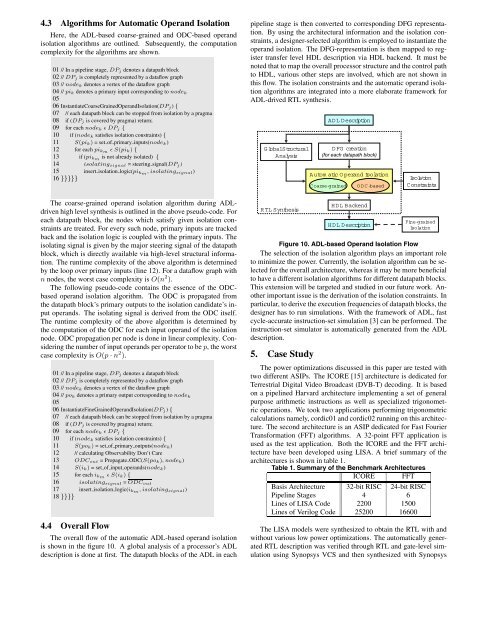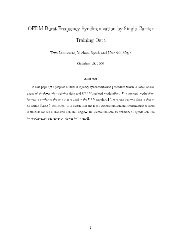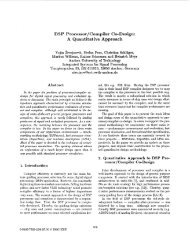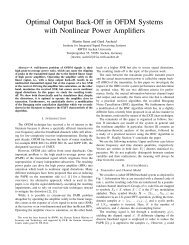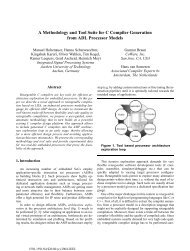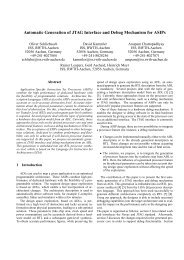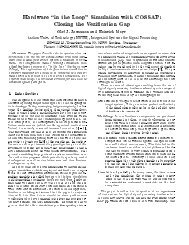Automatic ADL-based Operand Isolation for Embedded Processors
Automatic ADL-based Operand Isolation for Embedded Processors
Automatic ADL-based Operand Isolation for Embedded Processors
You also want an ePaper? Increase the reach of your titles
YUMPU automatically turns print PDFs into web optimized ePapers that Google loves.
4.3 Algorithms <strong>for</strong> <strong>Automatic</strong> <strong>Operand</strong> <strong>Isolation</strong><br />
Here, the <strong>ADL</strong>-<strong>based</strong> coarse-grained and ODC-<strong>based</strong> operand<br />
isolation algorithms are outlined. Subsequently, the computation<br />
complexity <strong>for</strong> the algorithms are shown.<br />
01 // In a pipeline stage, DP j denotes a datapath block<br />
02 // DP j is completely represented by a dataflow graph<br />
03 // node k denotes a vertex of the dataflow graph<br />
04 // pi k denotes a primary input corresponding to node k<br />
05<br />
06 InstantiateCoarseGrained<strong>Operand</strong><strong>Isolation</strong>(DP j ) {<br />
07 // each datapath block can be stopped from isolation by a pragma<br />
08 if (DP j is covered by pragma) return;<br />
09 <strong>for</strong> each node k ɛDP j {<br />
10 if (node k satisfies isolation constraints) {<br />
11 S(pi k ) =setof primary inputs(node k )<br />
12 <strong>for</strong> each pi km ɛS(pi k ) {<br />
13 if (pi km is not already isolated) {<br />
14 isolating signal = steering signal(DP j)<br />
15 insert isolation logic(pi km , isolating signal )<br />
16 }}}}}<br />
The coarse-grained operand isolation algorithm during <strong>ADL</strong>driven<br />
high level synthesis is outlined in the above pseudo-code. For<br />
each datapath block, the nodes which satisfy given isolation constraints<br />
are treated. For every such node, primary inputs are tracked<br />
back and the isolation logic is coupled with the primary inputs. The<br />
isolating signal is given by the major steering signal of the datapath<br />
block, which is directly available via high-level structural in<strong>for</strong>mation.<br />
The runtime complexity of the above algorithm is determined<br />
by the loop over primary inputs (line 12). For a dataflow graph with<br />
n nodes, the worst case complexity is O(n 2 ).<br />
The following pseudo-code contains the essence of the ODC<strong>based</strong><br />
operand isolation algorithm. The ODC is propagated from<br />
the datapath block’s primary outputs to the isolation candidate’s input<br />
operands. The isolating signal is derived from the ODC itself.<br />
The runtime complexity of the above algorithm is determined by<br />
the computation of the ODC <strong>for</strong> each input operand of the isolation<br />
node. ODC propagation per node is done in linear complexity. Considering<br />
the number of input operands per operator to be p,theworst<br />
case complexity is O(p · n 2 ).<br />
01 // In a pipeline stage, DP j denotes a datapath block<br />
02 // DP j is completely represented by a dataflow graph<br />
03 // node k denotes a vertex of the dataflow graph<br />
04 // po k denotes a primary output corresponding to node k<br />
05<br />
06 InstantiateFineGrained<strong>Operand</strong><strong>Isolation</strong>(DP j ) {<br />
07 // each datapath block can be stopped from isolation by a pragma<br />
08 if (DP j is covered by pragma) return;<br />
09 <strong>for</strong> each node k ɛDP j {<br />
10 if (node k satisfies isolation constraints) {<br />
11 S(po k ) =setof primary outputs(node k )<br />
12 // calculating Observability Don’t Care<br />
13 ODC out = Propagate ODC(S(po k ), node k )<br />
14 S(i k ) =setof input operands(node k )<br />
15 <strong>for</strong> each i km ɛS(i k ) {<br />
16 isolating signal = ODC out<br />
17 insert isolation logic(i km , isolating signal )<br />
18 }}}}<br />
4.4 Overall Flow<br />
The overall flow of the automatic <strong>ADL</strong>-<strong>based</strong> operand isolation<br />
is shown in the figure 10. A global analysis of a processor’s <strong>ADL</strong><br />
description is done at first. The datapath blocks of the <strong>ADL</strong> in each<br />
pipeline stage is then converted to corresponding DFG representation.<br />
By using the architectural in<strong>for</strong>mation and the isolation constraints,<br />
a designer-selected algorithm is employed to instantiate the<br />
operand isolation. The DFG-representation is then mapped to register<br />
transfer level HDL description via HDL backend. It must be<br />
noted that to map the overall processor structure and the control path<br />
to HDL, various other steps are involved, which are not shown in<br />
this flow. The isolation constraints and the automatic operand isolation<br />
algorithms are integrated into a more elaborate framework <strong>for</strong><br />
<strong>ADL</strong>-drived RTL synthesis.<br />
GlobalStructural<br />
Analysis<br />
RTL Synthesis<br />
<strong>ADL</strong> Description<br />
DFG creation<br />
IRUHDFKGDWDSDWK EORFN<br />
Autom atic O perand <strong>Isolation</strong><br />
Coarse-grained<br />
HDL Backend<br />
ODC-<strong>based</strong><br />
HDL Description<br />
<strong>Isolation</strong><br />
C onstraints<br />
Fine-grained<br />
<strong>Isolation</strong><br />
Figure 10. <strong>ADL</strong>-<strong>based</strong> <strong>Operand</strong> <strong>Isolation</strong> Flow<br />
The selection of the isolation algorithm plays an important role<br />
to minimize the power. Currently, the isolation algorithm can be selected<br />
<strong>for</strong> the overall architecture, whereas it may be more beneficial<br />
to have a different isolation algorithms <strong>for</strong> different datapath blocks.<br />
This extension will be targeted and studied in our future work. Another<br />
important issue is the derivation of the isolation constraints. In<br />
particular, to derive the execution frequencies of datapath blocks, the<br />
designer has to run simulations. With the framework of <strong>ADL</strong>, fast<br />
cycle-accurate instruction-set simulation [3] can be per<strong>for</strong>med. The<br />
instruction-set simulator is automatically generated from the <strong>ADL</strong><br />
description.<br />
5. Case Study<br />
The power optimizations discussed in this paper are tested with<br />
two different ASIPs. The ICORE [15] architecture is dedicated <strong>for</strong><br />
Terrestrial Digital Video Broadcast (DVB-T) decoding. It is <strong>based</strong><br />
on a pipelined Harvard architecture implementing a set of general<br />
purpose arithmetic instructions as well as specialized trigonometric<br />
operations. We took two applications per<strong>for</strong>ming trigonometric<br />
calculations namely, cordic01 and cordic02 running on this architecture.<br />
The second architecture is an ASIP dedicated <strong>for</strong> Fast Fourier<br />
Trans<strong>for</strong>mation (FFT) algorithms. A 32-point FFT application is<br />
used as the test application. Both the ICORE and the FFT architecture<br />
have been developed using LISA. A brief summary of the<br />
architectures is shown in table 1.<br />
Table 1. Summary of the Benchmark Architectures<br />
ICORE FFT<br />
Basis Architecture 32-bit RISC 24-bit RISC<br />
Pipeline Stages 4 6<br />
Lines of LISA Code 2200 1500<br />
Lines of Verilog Code 25200 16600<br />
The LISA models were synthesized to obtain the RTL with and<br />
without various low power optimizations. The automatically generated<br />
RTL description was verified through RTL and gate-level simulation<br />
using Synopsys VCS and then synthesized with Synopsys


